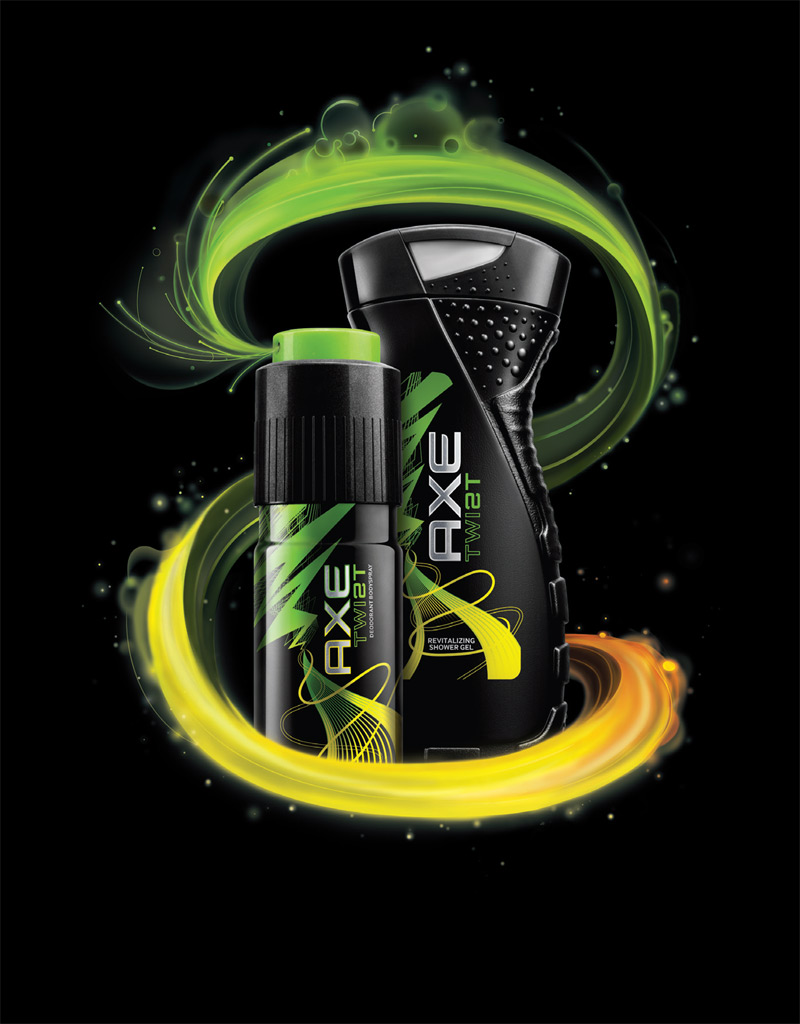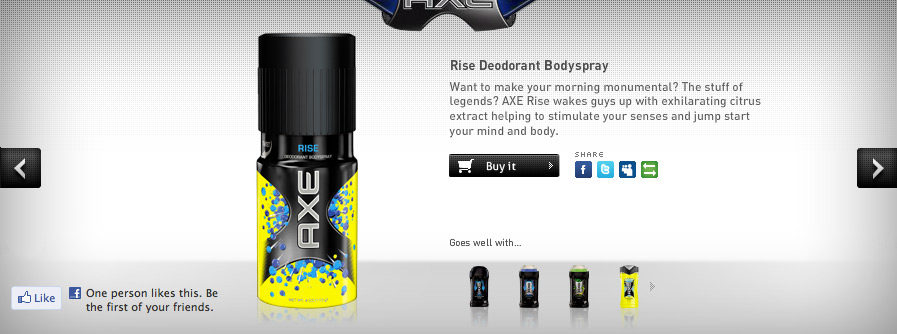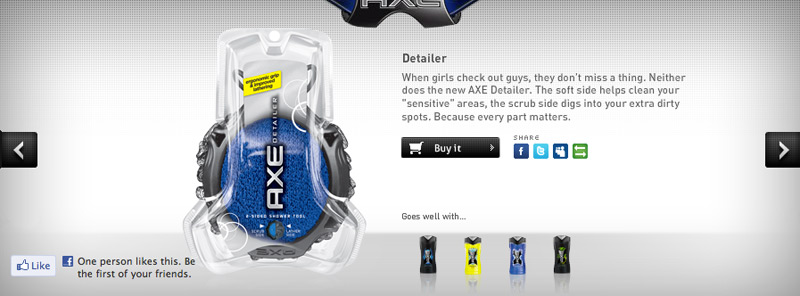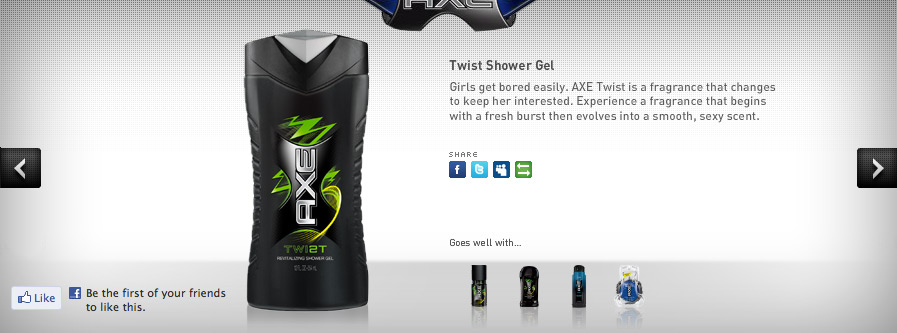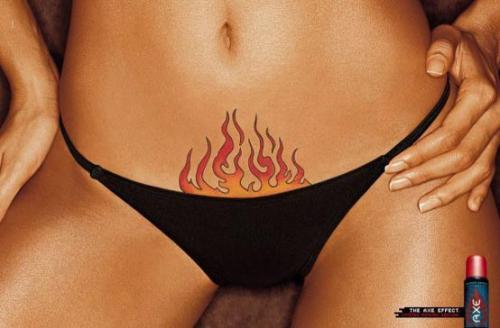Body Horror
Keywords: Antonio Trecel Diaz, Axe, Axe Body Spray, Body Spray, Fashion, Hard Body, Soft Scrub
Soft Scrub, Hard Body
Sound the alarm. A dude needs his daily cleaning. Time to get the scum of last night off his skin. In the opening moments of a recent advertisement for the Axe Detailer tool (a strangely futuristic reincarnation of the shower puff) a dude is doing just that. Fastened into the inescapable foot holds of a conveyor belt, he moves through an assembly of cleaning techniques. As the procedures differ, the weapon of choice remains the same. The Detailer is an oddly shaped orb. Like a perverted and transparent rendition of a synthetically made blob. The backdrop of this advertisement operates like futuristic skin flick, the sound of mutating techno and clamping mechanisms penetrate the senses. In the steamy confines of this sci-fi inspired romp through cleanliness, his passivity and irrevocably laconic movements, allude to a general air of trust in the machine carrying him towards cleanliness. In quite a redemptive manner, it seems as though he’s being pulled toward an ideal version of himself. Rising from a unacceptable version, metamorphosing into something more ideal. All at the expense of the Detailer. His journey moves from soft scrub to body buff.
With the tactility of the machines shiny and metallic infrastructure, and the overall blase attitude captured through his perfunctory glances, our dude moves through the human carwash, and gets what he thinks he deserves. Clean. Here, the economy of secretion is given over to the pristine, and somewhat clinical robotic device, which then whisks him toward more socially excepted waters. Last night, however perverse or party filled, is now being systematically scrubbed away. The dude has more important thinks to think about, obviously. Washing shouldn’t be one of them.
Our dude’s trust not only lies – first and foremost – in the overall capability of the machine, but – secondly – in the individual components upon which the machine runs. These internal cogs are portrayed by women. Brute chicks, covered in utilitarian garb, nonetheless. Not particular organic, but a cyborg like infusion of (wo)man and machine. This man must encapsulate the title of dirty, defiled – or un-hygienic – but only as he rushes away from it. Upon immediate entry into this world of “cleanliness,” the hyper-fragmentation of the Axe aesthetic (of which I will return to later) breaks down of the male figure into anatomical components. At the site of this fracture, segmentation ensues. Left breast, right breast, undercarriage etc. Breaking down the man with soap, various scrubbing techniques, and hot water, concurrently, makes the man stronger, more masculine, and thus, more useful in the cogs of society. However, the women have a defiant agenda to make this man “clean” – or disrupt soiling and the mischievous influx of bacteria – is certainly a by-product of modernity’s hyper-acceleration toward the clinical. Remaining pristine, and producing the same shimmer, and ultra clear resolution that’s represented in our devices. The body is, of course, a kind of screen. But is simply washing it, a way to achieve a transcendent and ultra-crisp resolution? Each scrub, each soapy lather conceals – and even camouflages – the dudes innate being. Not only rinsing him of his saturated filth, but, more importantly, reveling a complex system just below the surface. As the women clean him, they contribute to his ascent toward social acceptability, especially as a desired sexual partner. He’s getting laid tonight. No doubt about that. Only question is…who’s the lucky lady? Gorging itself on the dominant discourse of a heteronormative distribution of the senses, the good people at Axe have ubiquitously set up shop to sell pre-packaged Dudes. Men flock to soak up Axes’ muscular ideas, inject the steroids of their rhetoric, and gulp down the high-octane fuel of their aesthetic.
Thankfully, the folks at Axe have a penchant for solidifying, and perpetuating, these heteronormative ideas of masculinity. Otherwise, what would we do? Utilizing Friday night for optimal sexual escapades; imbuing the man with the right to take precedence over his primordial lust, Axe places emphasis on these normative ideas of maleness. Setting the parameters and bandwidth for masculinity, based on carnality and animalistic tendencies, Axe also deals in the transmissible logic of allowing man to pass through his desires. In doing so, Axe becomes the prism through which heterosexual men contort and fragment their existence. This process of passing, transitioning from one phase space to another – a metamorphosis, you could say. Passing from an undifferentiated mass of flesh, to clean, socially acceptable, and “distinguished” men. Men with a thrust for sex. Although I wouldn’t go so far as to call them gentlemen. Yet, what’s so interesting about Axe is that it’s a process of making and/or producing man. And this takes place through the production of scents, and most importantly, in the rhetorical tactics and aesthetic strategies.
Axes’ design and language reflects, and almost celebrates, the post-post-everything consumerism in which we find ourselves currently enmeshed. Neon color palates, hallucinogenic looking trails, metallic contours, harsh deconstructed angles, and jagged tribal designs all champion the aesthetic. Think of Zaha Hadid’s architectural fantasies, compressed and rushing toward the pixelation of the jumbotron and maximalist pyrotechnics of the Superbowl halftime show. That is, if the Superbowl were held in an holographic rainforest. Or, consider a wounded sniper, fighting for his life in the desolate jungles of Southeast Asia. Testosterone leaking from all available pores. Sweat glistening, as his faded haircut sparkles, and he screams out for the cosmos to recognize him. To pay him one last once of attention before the black hole of death swallows him whole. Such analogies poke and hint at capturing the Axe aesthetic, but they always all just shy of fully representing it. This is an aesthetic that thrives on being weird, idiosyncratic, but at the same time, produces a kind of qualitative value that seems almost intrinsic to contemporary culture. Especially that of deconstruction and abstraction. The same underlying themes of our current hyper-capitalism, reflect back from the packaging, with blinding precision.
The purpose of this piece is to perform a sweaty exorcism; to extract, revive, and question the relationship between language, the image, and the body. The best suited vehicle for this is the economy of glands; or, rather the glandular economy. This economic sub-structure – as it may be referred to – exists not in opposition to the attention economy of technological manifestation, but next to, within, or underneath of it. It’s a primitive counterpart, the primordial brethren.
In recent years, the glandular economy has taken the back seat to the more promiscuous, and all pervasive digital economy. With the infiltration of screens, decentralized networks of information, financial abstraction, and gadget culture, the warm womb of data demands all of our attention. But what happens when we look – or direct our nostrils – back to the gland? Consider this an attempt to get revive, reconfigure, and revel in the interconnectedness between the previously mentioned economies. We have so much to learn from our own secretions. Folks, welcome to the glandular economy.
Investing In a New Economy
Body odor is a dissemination of information. Simple and plain. Sweat glands produce secretions to regulate overall body temperature. Although, an overabundance of this information will lead to a radiating stench, at its core, body odor, will always be information. To secrete a scent is to be active; to mark the territory of oneself, and, in a way, to excrete life. But to produce too much of this information is a completely different story. And the result is a pungent, and at times, sinister scent. One we try to avoid at all costs.
Similar to the crosshairs of a sniper’s rifle covering the targeted face with routine efficiency, body odor is akin to the ensuing decapitation that spurts, and quarantines, the body from further human contact. Game over. The possibility of a mate has just been destroyed. Or has it? But let us not forget, this stench have potentially useful tendencies as well. In so far as it commands the attention of individuals, corporate entities, advertising and marketing firms to focus on it. This is where the glandular economy resides. Ah, good ole glands. We all have them. We all are subject to their secretions. Yet, glandular production, dissemination, and overall presence needs to be resuscitated from the ruinous anonymity from which it has been falsely displaced. As we zoom in closely, it becomes evident that it (the restructuring of these economical forces) is more an issue of human interiority vs. inhuman exteriority, rather than a particular fondness for one or the other. This is the situation which we are dealing with. Or, dealing in rather.
Certain smells not only produce critical interpretations but actually direct and re-direct them. Frequently too, these critical insights actually immerse themselves in the stench, using it as a vector for their analysis. These smells carve out realities, probe inquisitively, and are either indoctrinated into, or castigated from, societal frameworks. We think through these smells to access, critique, and reconsider eroticism, hygiene, and social relations.
The shameful by-product of bacterial orgies, body odor has at one point or another, infiltrated each and everyone of us. No matter how gruesome or appalling the scent may be, body odor becomes an immediate vector for marginalization. It pulls and contorts the perception of oneself, human viability, and self-care into a grotesque state of alienation. Or, at least those brave enough to admit it. In some cartoonish fashion, these virulent and pesky odor particles, swarm and coagulate, producing an all encompassing fuck-fest of growth. A perspiring fog that “reeks” havoc on our olfactory glands. The squiggling green lines of stench squirm out of the body, and demand our attention immediately.
Man nor woman wants this opaque seal of disapproval following them. Sweat stains are, undoubtedly, the mark of the beast. But these smells do indeed provide a very interesting context, and remind of us the deeply primordial ties to which they are – and we are for that matter – sequenced. Everyone has a slightly different scent. Everyone is a participant in the Glandular Economy. If examined more closely, body odor, is the patron saint of regulating, ordering, and distributing both individuals, and the larger social body. With this in mind, we must ask the important question: how do the concepts of fragmentation, deconstructionism, and abstraction tie grooming products to the economies of attention?
We’ve all heard the somewhat buzz term “attention economy” tossed around in recent years. Especially as the volatile abundance of information, morphs, begs, and screams out for us to notice it. In its most primitive form, economy can be seen as a conceptual platform, structure, or market. External forces are constantly intervening, making it (the structure) susceptible to fluctuation, instability, growth, and/or decline. Keeping this in mind, the buzz-term by which attention is situated, falls victim to privatization, exhaustion, abuse, and other capitalistic tendencies. Take notice it says, for its market is extremely competitive and compact, and the immediacy of us giving ourselves over to it becomes its main goal. Its message and content become secondary, getting us to notice it takes precedence over all. This information needs our attention, as it uses us for its proliferation; it uses our attention to breed. Without us noticing it, and thus giving it life, information has an extremely short, and in-opportunistic shelf life. It dissolves.
This economy of attention comes in various forms, shapes, and concepts. In reviewing material for the construction of this piece, these impatient deities have taken the shape of paraphilia related wikipedia entries, graphically fetishistic websites involving arm-pits, and a myriad images highlighting hygiene products for men. Regardless of shape or size, these variably shifting formats all want stake in my attention. I keep asking myself which one takes precedence over the next? As our attentional frontier becomes overly commodified, and thus more and more scarce, it’s equally as important to theorize, deconstruct, and reconstruct exactly where attention resides, and trace its channels of distribution. These channels emerge as crystalline pixels, digital voids of escapism, networked patterns, info-maximalism, and marketing hype. Or, rather a surplus of locations to direct one’s mind.
While the cyber-blitz, schizophrenically vies for our attention – reconfiguring how we absorb the immaterial, as well as how we process it against the influx of other informational content – another more primitive, and under looked, economy is concurrently playing out. One that is directly underneath our nostrils.
The economies of attention are nothing new, they’ve existed for thousands of years. Spanning from our initial bi-pedal engagements, which lead our attention to the accumulation of berries and other food stuffs; to defining objectivism through the distribution of attention to nature and the life sciences, external phenomena has begged for us to engage with it. For purposes of maintaing to human existence to understanding the complex system of which we are only a small part, our attention is an extremely valuable asset. And even a commodity. Now one must ask: what happens as the ultra-competitive attention economy as draws its attention toward the proliferation of sweat? Alternatively, this economy deals in the currency of the subterranean. One that is both under nostrils and leaking out of our bodies. A currency that creeps out of arm pits, by way of glands, hormonal secretion, and omnipotent stench. More importantly, what happens as the ultra-competitive attention economy as draws its attention toward the proliferation of sweat? Cleanliness is said to bring us closer to god.
In fact, sweating serves a specific bodily function. This we all know. As the temperature inputs in the skin are affected, body temperature rises to compensate for the recent fluctuation. This smell, one of conquest and human domination, is the stench of bacterial growth and hormonal secretion. Our body odor only demands enough of our attention to cover it up. It hides behind our focus, and then lurches out in a problematic fashion. However, it can be a very fine line between the celebratory – and quite sexy – dissemination of pheromones, and the outright rank stench of a partner, passer-by, or friend. But, unplugging the cosmic nostrils, and re-thinking the body and its economies, is it possible re-think the body through both the smells it produces, and the products used to conceal them? We shall find out.
A New Future for Hygiene
Being a man, I’m left to ask where can I direct my attention for glandular support? Who’s going to take care of my pits? Where is it I should focus my attention, when trying not to stink? In the extravagant, and at many times ostentatious, landscape of contemporary grooming products, finding the right body-spray or deodorant can be like walking into an unevenly distributed game of russian roulette. More bullets than participants. All aligning players nervously gesticulate while their decision making is reliant on external factors: probabilities. Chance produces more courageous survivors than exposed brain matter. But it does expose one unlucky chap. There’s a certain tyrannizing that accompanies one’s capacity to select a scent. Much in that way that the single bullet creates an air of despotism; the body-sprays, shower gels, and deodorants maintain a similarly threatening gaze. Axe (or Lynx, as its referred to in Europe) and Old Spice are the major players in the game, yet the focus here remains on Axe. Precisely because it’s the more interesting of the two – with its nod to the same maximalist, angular, and fragmented aesthetic tendencies, proliferated through financial abstraction and digitization.
Axes’ design and language reflects, and celebrates, the post-post-everything consumerism in which we find ourselves currently enmeshed. Neon color palates, hallucinogenic trails, metallic contours, harsh deconstructed angles, and jagged tribal designs all champion the aesthetic. Here formalist congruency is shattered, whole shapes deconstructed, indented, scratched, and stretched to their varying limits. Compression and asymmetry become the dominant paradigm. Glowing in the the same crystalline definition, these high-res fractals and jagged tribalisms, swirl, and contort the reality of 21st century body odor and masculinity. Hygiene has never looked so futuristic. Yet, the synergistic relationship that emerges between graphical representation (i.e., the packaging), and the production of identity (as seen by perpetuating heteronormative tropes associated with the use of the products), is in a way, a potential diagram for the chopping and re-distribution of anthropocentric history. A specifically masculine history at that. Sadly, this potential is never quite fully realized or articulated.
In ripping open the void, Axe momentarily exposes the internal mechanisms connecting the primal to digital. Man to machine. And vice versa. These scents, product designs, advertisements, and aesthetic ecologies serve as a counterpart to this bloated spectacle; feeding on the chronology of male hormonal production, trading the pungent scents of yesteryear for a transgressive illumination. An illumination that, sadly, is only the residue of visual communication – or a strong team of designers. But while Axes’ relationship between economies of attention, masculinity, and rhetorical strategies, draw correlations between hyper-fragmentation, new aesthetic paradigms, and contemporary culture, Axe, simultaneously, falls short in utilizing their position to re-apply these same tactics, and reconfigure traditional masculine tropes – or as much of their design brilliantly hints toward.

What’s interesting about the relations arising between the rhetoric and design of Axe products, is that while remaining indebted to heterosexual masculinity and testosterone, Axe also focuses on the extrinsic capacity of man. That which surrounds him; or more specifically, the data flow enveloping each and every one of us. Female, Male, or other. Perhaps this exteriorization – depicted in the cyber-tribalism and pixelation of the Axe aesthetic – seeks to, momentarily, capture the residual effects of this data flow, presenting them as a mirror in the form of deodorant’s packaging. Could we be so lucky to see our reflection, but so unaware of actually how to look at it? Could we use these graphics, these visual designs to move closer toward instituting a unisexuality? This data flow is a vast space of emasculatory potential, remaining fluid, volatile, whilst resisting temptation to conform or solidify. Thus, a space brimming over with feminine, queer, or trans capacities. Capacities that contribute in destabilizing the dominant paradigms. Although, Axe just doesn’t quite know this yet. Conversely, phrases like, “When girls check out guys, they don’t miss a thing” or “Girls get bored easily. Axe twist is a fragrance that changes to keep her interested.” As forward thinking and idealistic as their design may illustrate, all is lost as the language paints the heterosexual male back into a pre-fabricated version of himself. He becomes a cage within a cage. A system of possible liberation put forth by the aesthetic, then closes on itself, slamming the door in the face of emancipation. Even body odor falls victim to incessant control.
With such a vested interest in transgressive policy, the potential for Axe to usurp traditional models of masculinity come at a grand disappointment. The imagistic fashioning of their hyper-abstraction and torqued up acclerationism – as illustrated by their design practices – clashes against their fundamentally flat, and inane, use of language used to frame and differentiate between ideas of gender and sexuality. Identitarian liberation rises from the flames of body odor, like an olfactory based phoenix, only to dissolve as the heterosexual male retreats back into a pre-fabricated version of himself. If the design illustrates such a deconstruction of formalism, and mimics the hyper-abstraction produced by something like the financial system, we must read them as an instruction manuals for future renditions of the body, information, and sexuality. And not only allow these new aesthetic paradigms to provide us with insight, but, more importantly, incite action. Action in the form obliterating gendered norms, and maybe even, playing with the ideas of unisexuality. I mean it is almost 2012, and the binary dualisms of yesteryear still claw, and differentiate in a extremely regressive manner. Can we not push forward toward androgyny?
Boasting of an ergonomical grip and improved lathering capabilities, let us circle back around to the item that prompted me to even consider writing this; The Detailer. While the advertisement plays out, we see the dude pass from soft scrub to body buff; from man dirty to clean dude. Gleaming from his freshly assaulted undercarriage, he exits the industrial shower clinging to the carved out reality Axe has created for him. Only de-stabilized, or momentarily emasculated, our dude’s identity remains in tact, and confined to the sexual dualisms and binary aggregates of Axes’ rhetorical frameworks. His tool of choice glistens in the background. A device for the preservation of masculinity. The only remaining question is: how will you prepare yourself for the glandular revolution?
